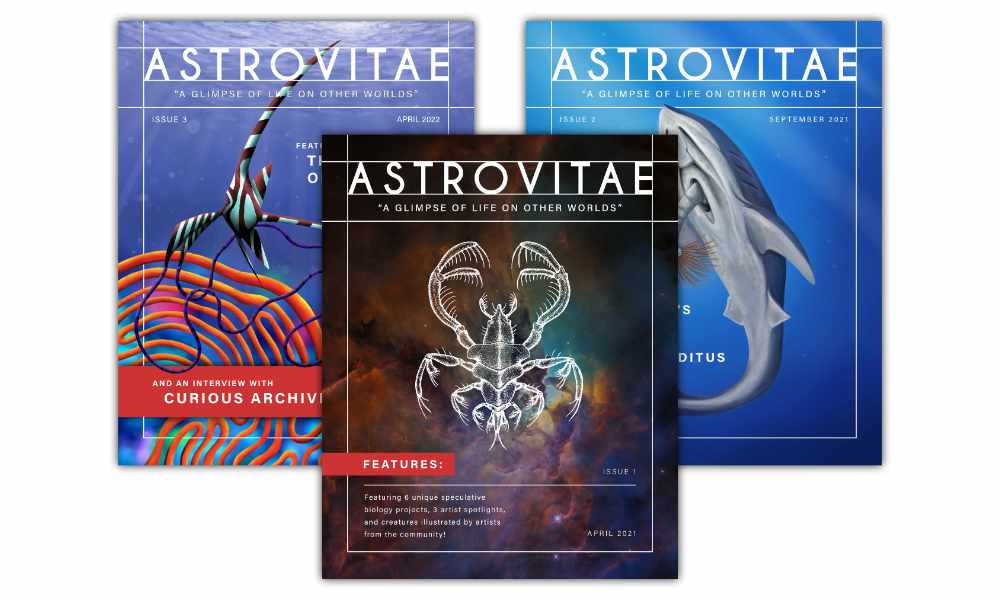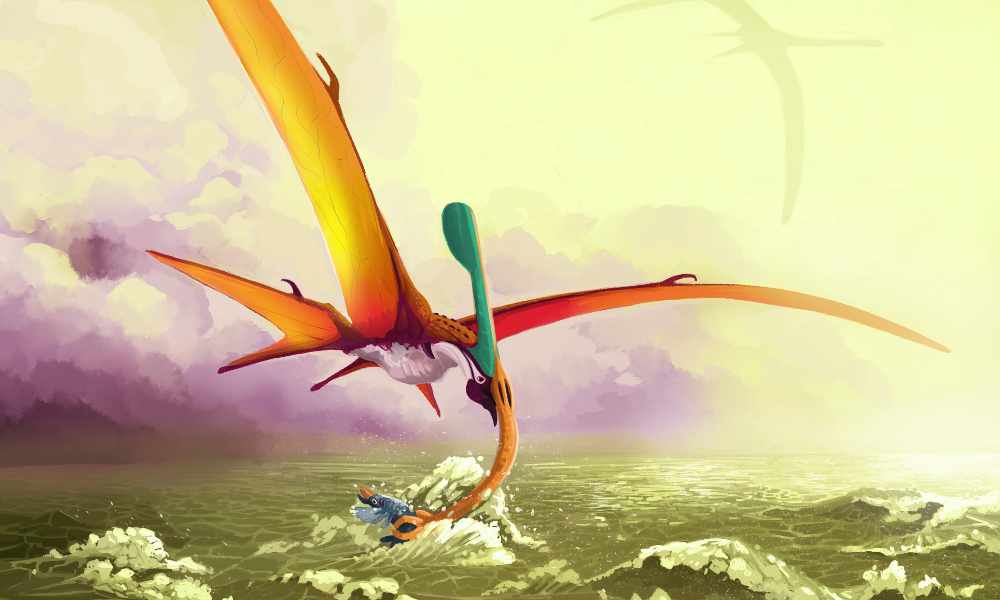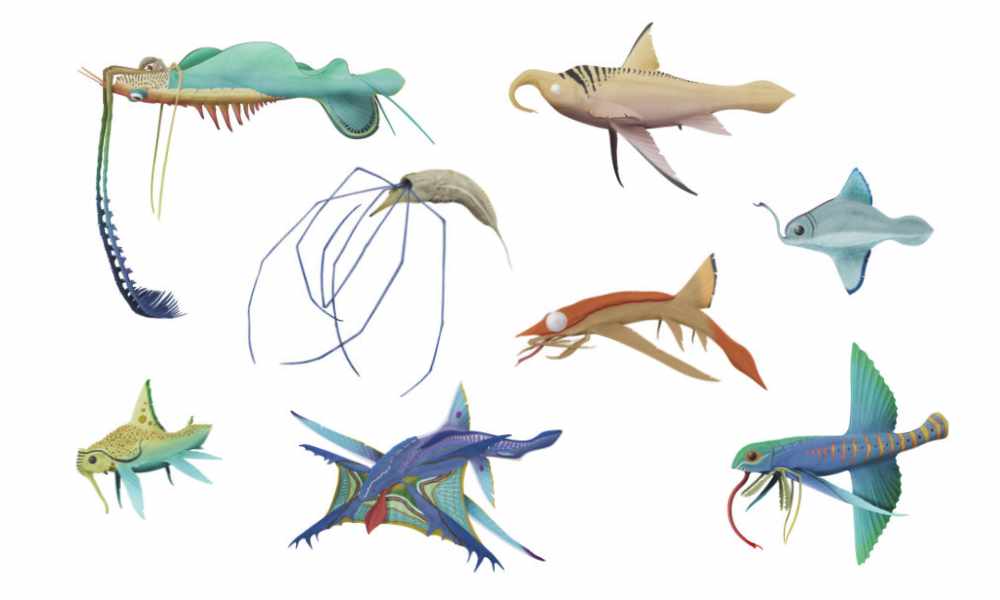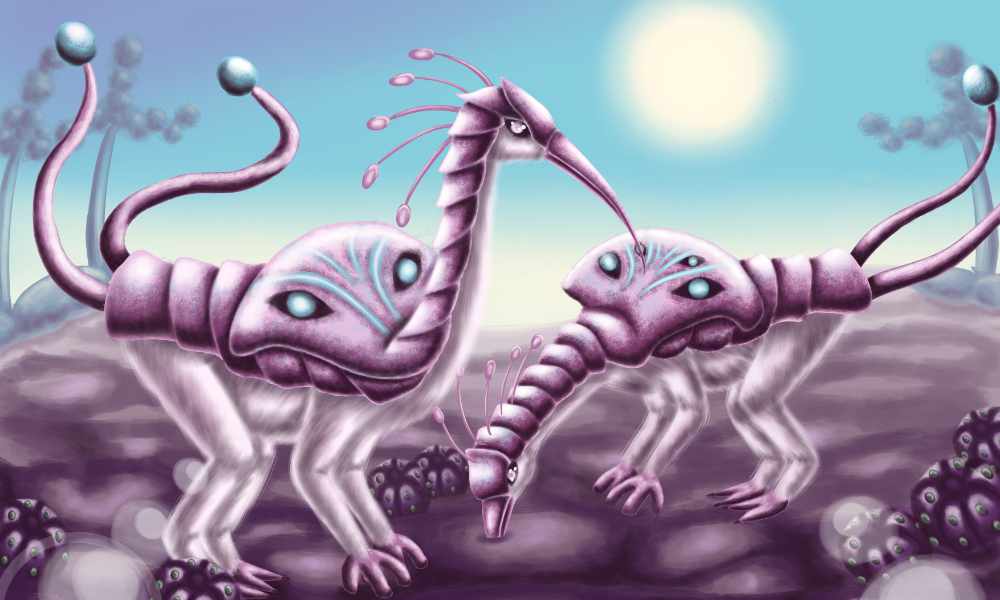Alife News
The Artificial Life Community Newsletter

A word from the team
Welcome to the 7th issue of the ALife Newsletter. Last month we had the yearly meeting of the International Society of Artificial Life (Alife 2022), which we hope was as inspiring for everyone as it was for our team.
We are terribly grateful and humbled by receiving the ISAL Exceptional Service Award. We would like to thank everyone who has made contributions to these Seven Editions, and everyone who has taken the time to read our collection of Artificial Life news and interesting projects. We hope to continue serving as a platform to amplify the voices of our community, and raise awareness of cool and inspiring projects to everyone.
Speaking about cool and inspiring projects, in this edition we highlight some great projects, including droplets, cultural simulations, speculative bio art, media reviews and more! We hope you enjoy it.
The Newsletter is distributed by email, and archived on the International Society for Artificial Life's website.
If you'd like to receive our e-mails, you can subscribe here.
Also, we encourage everyone to contribute to the next newsletter here (ETA October 2022)! In particular, we are specially interested in Master and PhD students who want to talk about their own research ideas. Do send us a line!
Lana, Imy, Mitsuyoshi, Claus and Katt.
- Complex Behavior of Paraffin Droplets
- Project Introduction: "Tell Me What You Eat"
- Astrovitae: The Speculative Biology Magazine
- Media Review: Prehistoric Planet
- ALIFE Conference Survey
- ALIFE 2022 Student Abstract & Essay Winner
- Book Review: Cybernetics (or, Control and Communication in the Animal and the Machine)
- Call for Volunteers
Complex Behavior of Paraffin Droplets
In these clips, paraffin droplets containing different concentration combinations of camphor and the dye Oil red O were placed on a pure water surface. Droplets develop different behaviors such as tendrils, which form a maze-like space filling structure before splitting into smaller droplets that periodically move and trigger waves of activity or slowly morphing larger droplets. The behavior comes from the camphor in the droplet/s being deposited onto the water surface where it lowers the surface tension temporarily until it evaporates from the surface again, causing a marangoni convection in the bulk water phase that triggers a surface flow. Furthermore, the dye in the droplet lowers the interfacial tension between oil and water which enables the droplet to expand without splitting immediately. For more on this: Richard's paper published this month: Complexity and bifurcations in the motion of a self-propelled rectangle confined in a circular water chamber; ALife 2018 paper: Better red than dead: On the influence of Oil Red O dye on complexity of evolution of a camphor-paraffin droplet on the water surface
Project Introduction: "Tell Me What You Eat"

"Tell me what you eat, and I will tell you what you are."
— Jean-Anthelme Brillat-Savarin
If you want to understand a group of humans — where they live, how they speak, what they value, how they use their time or what they are proud of, a good place to start is with how they eat.
We'd like to place the deep bond between food and culture at the heart of an interactive experience: What can you learn from a group of people, based on what they eat?
Explore a world through its cookbook
Tell Me What You Eat is an in-development game where players are invited to discover human cultures living in a fictional world, using their cooking practices as a red thread. If I tell you how they prepare food, can you piece together their history, where they lived, how they spoke, what they loved?
We intend to make Tell Me What You Eat a sort of generative detective game: each time you replay it, the world you explore will be recreated anew. New landmaps, new plants, new populations, new historical events — that will in turn, influence the recipes of this world. You might want to cook one of these recipes yourself, or try to imagine with your friends which kind of world exist around them.
Prototypes & Experiments

Our various prototypes and playful experiments are all available on the Github repo.
The repository contains:
- a first rough prototype of generating a fictional world's cookbook;
- a tentative at cooking a fictional recipe;
- a simulation of how places get their names from the people they are traversed by;
Editor's note: Many Alife projects focus on the evolution of biology, agency, and intelligence. But another important aspect of living creatures is the culture they produce by their lived experiences!
Astrovitae: The Speculative Biology Magazine

Hello ALifers! I’m Domenic Pennetta, the founder and editor of Astrovitae Magazine—an online publication focused on popularizing the genre of fiction called speculative biology (specbio). Many of you have seen the first images taken by the James Webb Space Telescope, which recently made headline news around the globe. Now humanity can gaze into the universe once more, but this time with more accuracy and clarity. Looking at the vastness of space—taking in all of the brightly-lit stars, nebulas, and funny shaped galaxies… brings up a nagging question: Where is all the life?
Specbio artists take this question to heart. The universe is, no doubt, full of life. We just haven't found it yet! And since alien life is most certainly out there, then what does it look like? Astrovitae’s mission is to gather up all these curious minds—all sharing the same goal of exploring what alien or alternate Earthly life could be—and put them in one place. This nexus of creatives fosters collaboration and a strong sense of community, while also providing many with thoughtful biology-inspired entertainment. With a slogan like “life as it could be'', I’m confident that many ALifers can sympathize with specbio artists and our search for a different form of life.

“Crested Snout Skimmer”, by Pierce Adams.
What is Astrovitae Magazine All About?
Astrovitae is a FREE, digital magazine focused on showcasing topics involving speculative biology, art, and science fiction. The magazine releases biannually, with a new issue planned to appear every April and September. The magazine is not peer reviewed, and there is no masthead or advisory board—the founder of the magazine is currently the only editor (who occasionally receives outside help from friends and other artists). The very first issue debuted in April of 2021 amid the global pandemic, and so far, there have been three published issues featuring a variety of artists and projects. Issue 4, which is now in the works, releases this coming September! New issues can be found on the magazine’s website: www.astrovitae.com.
What’s Inside an Issue?
Inside a typical Astrovitae issue are three main categories:
- Captivating Worlds: This is the primary content in Astrovitae where specbio artists showcase their unique world, biomes, and creature designs. Captivating Worlds contains the most detailed representation of a specbio project.
- Artist Spotlight: Artist Spotlight is typically less refined—focusing on the "behind the scenes" of a speculative project. Creators have an opportunity to speak about their creative process, inspirations, and can also show off sketches and unfinished art.
- Creature Compendium: This section is exactly what it sounds like—it's a collection of various creatures by participating artists! These organisms are often accompanied by a brief description that gives the reader a small snippet into another speculative world.

“A Variety of Enetodontians”, by Lorenzo Battilani.
There are also other segments included in Astrovitae, such as Spec News—a section that updates readers on some of the going-on’s in the community, like newly announced specbio projects, youtube content, video game releases, and science news associated with astrobiology, paleontology, and other fields.
Astrovitae occasionally features larger creators in interviews, such as Jay Eaton, one of the founder’s of the specbio zine called Almost Real, and the popular Youtuber Curious Archive. Some other notable people in the genre may be interviewed in the future, like the vertebrate paleontologist Darren Naish, artists C.M. Kosemen and Wayne Barlowe, and maybe one day the father of speculative biology himself, Dougal Dixon.

“Anatomy of a Spadecrab”, by Hunter Welch.
How Can ALifers Submit to Astrovitae?
Any ALifer interested in speculative biology may send a submission! Creating submissions does not require an art or science degree, nor do you have to be a professional artist to submit work. However, Astrovitae does prefer submissions that include artistic visuals to engage its readers—so if you’re just an author-type, then it might be best to hold off on a submission unless you’d like to collaborate with artists. One of Astrovitae’s missions is to foster collaboration among creators, so working with other individuals in the community is highly encouraged!
If you’re interested in sending a submission to Astrovitae, then visit www.astrovitae.com/submissions to see the magazine’s official guidelines and additional information, like deadlines, word counts, image requirements, and more. Contributors are encouraged to read past issues to see what type of content is typically accepted. Send submissions to astrovitaeofficial@gmail.com with the subject line “ASTROVITAE SUBMISSION'' followed by your project’s or article’s name.

“The Tokabi”, by Maryana Simpson.
How Can I Support the Magazine?
There are a few ways to support Astrovitae:
- Spread the news! Word of mouth is the best form of marketing, so tell your friends, family, and peers about the magazine!
- Participate by creating your own submission! And don’t hesitate to encourage others to submit work of their own!
- Like, comment, and share Astrovitae’s Instagram posts.
- Donate to Astrovitae’s Kofi to support the editor’s efforts to popularize the genre and contributing artists!
Regarding donations, Astrovitae is not sponsored and currently makes no revenue from ads or sales. The magazine is absolutely FREE to read in its current state. Donations go a long way to help facilitate the production and marketing of an issue. You can donate a meager $3 (USD) or more to help support the magazine’s mission to showcase specbio artists in the community. If you're interested in donating, visit Astrovitae's Kofi to send a donation. Make sure to leave a comment about your favorite artist or project featured in the magazine!
Media Review: Prehistoric Planet
By Albert Chen

The following is modified from a longer review. Prehistoric Planet, a new documentary series now available for streaming on Apple TV+, has caused quite the stir in the online paleontology community. With its focus on reconstructing extinct life in ancient environments, this show inevitably invites comparisons to Walking with Dinosaurs (1999), but it borrows more from recent documentaries that focus on the modern biosphere, such as Planet Earth (2006) and its sequels. For example, each episode of Prehistoric Planet comprises several vignettes that take place in multiple locations, instead of revolving around a narrative about one specific ecosystem. In addition, the segments in Prehistoric Planet are all set within the Maastrichtian Age of the Late Cretaceous Epoch (spanning 72.1–66 million years ago, shortly before the mass extinction event that would end it all), not spread across the entire Age of Dinosaurs.
Most responses to Prehistoric Planet have been overwhelmingly positive, and the acclaim is well deserved. The series features spectacular visual effects as well as naturalistic, scientifically plausible depictions of extinct animals. An excellent example is the adorable portrayal of the small, feathered Mononykus, which appears in the second episode (“Deserts”) and is arguably one of the breakout stars of the series, with even executive producers Jon Favreau and Mike Gunton identifying it as one of their favorite dinosaurs that they featured. This dinosaur belongs to a group called the alvarezsaurids, characterized by their slender skulls, long legs, and most unusually of all, incredibly short but powerful arms that each end in an enlarged thumb claw. In Prehistoric Planet, Mononykus is shown traveling for long distances while foraging, detecting prey with its sensitive hearing, and using its specialized thumb claw to dig for termites in dead wood, all of which are behaviors that have been suggested for alvarezsaurids based on studies of their functional anatomy and ecology.
If I had any notable criticisms of Prehistoric Planet, it would be the fact that this extensive scientific background is probably not apparent to viewers unfamiliar with dinosaur paleontology, as the show generally does not clarify which elements are speculation and which are backed by direct evidence. Each episode does have an accompanying 5-minute “Uncovered” video that delves into some of the science behind the series, but each of these segments focuses only on a single narrow topic, leaving the majority of what is shown in the episodes unaddressed. If anything, a lack of transparency does a disservice to the tremendous amount of thought and research that clearly went into this show.
This point of concern, however, does not undermine the excellence that Prehistoric Planet has achieved. The series is outstanding in nearly every way possible, setting a new and extremely high standard for works of this genre. Given the positive reception so far, I feel hopeful that we will eventually see future seasons of Prehistoric Planet and, with luck, maybe even a whole new age of paleontology-inspired media.
ALIFE Conference Survey
by Anya Vostinar, ISAL Diversity Chair
Hello ISAL Members! We’ve just wrapped up a successful ALIFE 2022 and the ISAL board would like to get some feedback from you all on two specific aspects of conference organization, double-blind reviewing and extended abstracts, as well as any other comments or suggestions that you have.
Please complete the survey at this link by September 6th.
Thank you for all of your involvement in our ALife community!
ALIFE 2022 Student Abstract & Essay Winner
Large Language Models (LLMs) (Devlin et al., 2018) have propelled breakthroughs in sequence modeling by pre-training on large web corpora, to the point of seemingly incorporating “universal” knowledge (Lu et al., 2021). But, to what extent is such knowledge universal remains an open question. In other words, do LLMs ground knowledge that is so universal to solve far-fetched downstream tasks? Most notably, Reinforcement Learning (RL) agents lag behind the computational abilities of animals and they might benefit from the common sense embedded in LLMs as if those were world models (Ha and Schmidhuber, 2018). In particular, we wonder whether LLMs can be used as off-the-shelf reservoirs for RL tasks by simply optimizing a readout function on top of them. Proving that LLMs ground knowledge that is so universal to solve RL tasks would be a relevant discovery. As a consequence, being the LLM reservoir frozen, we can solve tasks by optimizing much fewer parameters than usual.
View the full submission and the other Student Abstract and Essay submissions here.
Book Review: Cybernetics (or, Control and Communication in the Animal and the Machine)
by Imy Khan
This book has been on my reading list for some time, and I had hoped that volunteering a review back in December would force my hand into reading it. Alas, carving out the time for it was tricker than I had hoped, and while I’m still not through it (I’m writing this review only six chapters in), I wanted to contribute this short piece in the hope that it might inspire others to pick up and read this, quite frankly, fascinating and insightful book.
A quick primer on cybernetics (though I’m sure many of us may be familiar with the term). Cybernetics is a field which concerns itself with regulatory, self-governing systems, attempting to provide a theoretical framework for the regulatory mechanisms and feedback loops that drive system stability or auto/self-regulation. While these systems were originally described from a biological perspective (partially, at least, since Wiener takes the position that the biological “brain” is the primary controller of regulation), the cybernetics principles can be (and have been) applied to systems across numerous scales and fields. These include biology, neuroscience, sociology, engineering, economics, robotics, and artificial intelligence. Closer to the field of ALife, cybernetics has also inspired biologically-relevant theories of self-regulation, such as autopoiesis, enactivism, and viable systems models. Cybernetics as a field, then, is both wide-reaching and cross-disciplinary and has found both theoretical and practical applications across many domains. It is fascinating to think that this is an approach that was developed over 70 years ago, and one that is continually finding relevance in our work.
My reasons for reading this book are simple: the work that I have done (by proxy of the lab where I completed my PhD) has been inspired by cybernetics (as well as other fields). After several years of using, citing, and, at times, defending this approach, I decided that it was only fitting to go back and read some of the original literature on the area.
To start, I have to say that this book is very dense. After a couple of introductory chapters, the book becomes quite heavy on mathematics very quickly - at times, there are several pages of mathematical equations all at once - but Weiner does an excellent job of narrating, commenting, and making analogies for the points he is putting forth. The mathematics is not unnecessarily verbose. On the contrary, Weiner is attempting (and, as it turns out, successful in doing so) to argue for a new perspective on communication (or information) theory as it relates both to animals and machines, drawing parallels between both. The explicit mathematical definitions, therefore, are used to strengthen this position.
I had to constantly remind myself that this book (well, the first edition of this book) was written in 1948, as some of the points that Weiner describes were incredibly forward-thinking and almost predictive of what would unfold in the fields of artificial intelligence, computer vision, and neuroscience. For instance, in the chapter, “Gestalt and Universals”, Weiner discusses how we (animals) can identify and recognise objects using generalisable features While this chapter is light on the mathematical formalisms of these mechanisms, Weiner’s discussions of the (theoretical) mechanisms responsible for this generalisation have perhaps found a home in the field of computer vision. In another instance, in one of the supplementary chapters (published in 1961, that I had a brief read of), Weiner also discusses the potential dangers of machine automation and self-reproducing machines. I don’t want to spoil the contents of the book too much, but his views and seemingly-accurate predictions of some of the social and political problems that may arise from self-replicating machines is, in itself, reason to read this book.
One of my favourite chapters (so far) is the chapter on “Computing Machines and the Nervous System.” Weiner speaks of the “affective tone”, with descriptors of “pleasure” and “pain”, and how they can affect other processes responsible for self-organisation. He also talks about how all of these different affective tones are themselves regulated by an “affective tone totalizer”, and also describes how this plays out in biological systems (through hormonal modulation of the nervous system). What Weiner describes here is the role of “emotional regulation” in biological self-regulatory systems, which I, personally, found to be an interesting perspective. Juxtaposed against the theme of the rest of this book, which emphasises the machine-like processes of inputs, outputs, feedback loops and regulatory systems, the description of a very animalistic quality---emotion---as both a regulator and, itself, regulated, was surprising. To me, this highlighted that Weiner cared just as much about the processes associated with the “animal” as he did the “machine”: a refreshing take in an era where strictly-computational approaches (such as those by von Neumann and Turing) were gaining prominence.
I briefly read some other reviews of this book before I wrote this review, and have seen people call its contents “disorganised” or “disjointed”. I certainly understand these points, but I respectfully disagree. As I mentioned above, Weiner is simultaneously attempting to define this new field of cybernetics, describe its potential applications across numerous domains, while also not shying away from his own opinions on certain matters. At least in my reading of this book, I get the sense that this was written by an incredible individual who is attempting to communicate their groundbreaking work to as many disciplines as possible. As we might all appreciate, interdisciplinary communication is hard work, and I do not hold that against Weiner or this book.
Overall, whether or not your research is directly related to cybernetics or its tangential principles, I would highly recommend that this book finds its way onto your respective bookshelves. Oftentimes, I found that even reading a few pages would spark an idea or two in my head, giving me a wider appreciation of how we can think of (almost) everything in terms of feedback loops and self-organising systems. Others have called this book worthy of reading as a historical document if nothing else. I am inclined to agree. It is not a casual read by any means, but one that I wish I had read years ago. Some of the ideas and theories may have been better refined in the 70 years since its publication, but it is clear to see how this book and his later works were crucial in laying the groundwork for many theories and applications that we take for granted in our own research nowadays.
Call for Volunteers
-
The newsletter is looking for volunteers to curate content and come up with new ideas! Contact lana.sinapayen {at} gmail.com
-
The Encyclopedia of Artificial Life is live and needs contributions!
-
How cool would it be to have an ALife podcast? If you are interested in helping out contact imytkhan {at} gmail.com